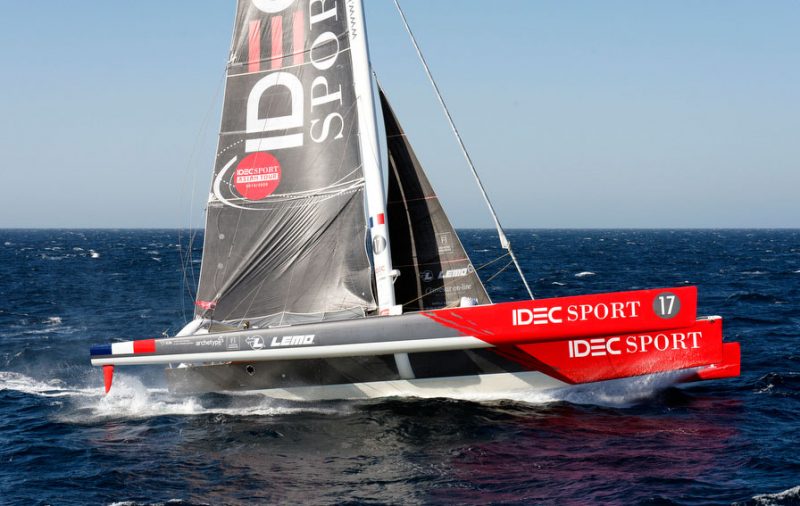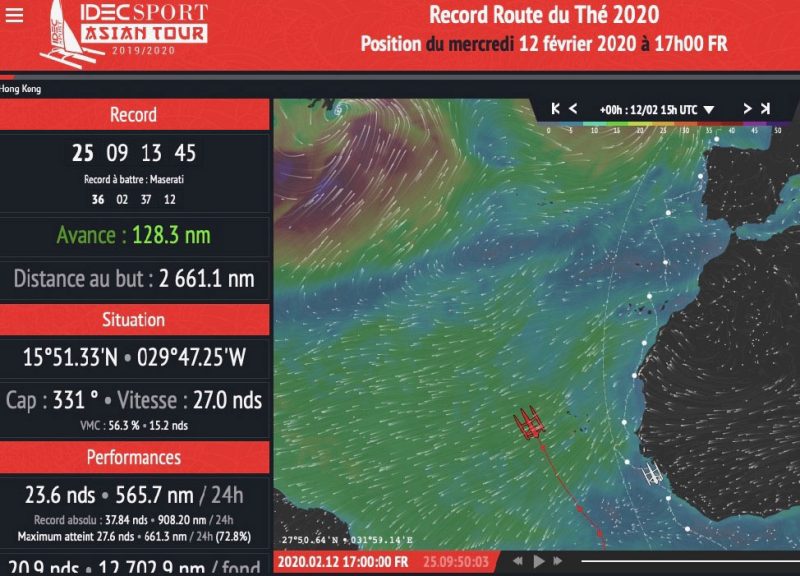
Cayard First Sailor in Sports Hall of Fame
The Bay Area Sports Hall of Fame (BASHOF) announced yesterday that local sailor Paul Cayard will join its 2020 induction class this May. In doing so, Cayard becomes the first sailor to be recognized by the BASHOF, joining sports-world greats such as Joe Montana, Jonny Moseley, Billie Jean King and Willie Mays.

“I grew up in this city and graduated from San Francisco State, so I’ve spent my entire life following the greats of Bay Area sports,” said Cayard. “To have earned a place among the heroes of my hometown is a tremendous honor for me. I am also extremely proud that the sport of sailing is being recognized in this arena.”
Cayard is a seven-time world champion and seven-time America’s Cup competitor. He has circumnavigated the world twice, becoming the first American to win the Whitbread Round the World Race in 1998 on EF Language. He placed second with Disney’s Pirates of the Caribbean in the 2005–2006 Volvo Ocean Race. Cayard is a two-time Olympian in the Star class (1984, 2004). He’s thus one of the very few sailors who have competed at the top level in these three diverse disciplines.

Cayard’s accolades include induction into the National Sailing Hall of Fame (2011), and US Sailing’s Rolex Yachtsman of the Year award (1998). He is a member of San Francisco Yacht Club and St. Francis Yacht Club, and currently serves as chairman of the board of the latter club. Cayard also serves on the board of US Olympic Sailing.
The 2020 inductee class will be honored at the 41st Annual Enshrinement Banquet of BASHOF on Monday, May 11, 2020, at the Westin St. Francis Hotel in San Francisco. Cayard will be inducted alongside Baseball Hall of Famer Rickey Henderson (Oakland A’s), Super Bowl champion Bryant Young (49ers), 12-time Olympic swimming medalist Natalie Coughlin and three-time World Series-winning manager Bruce Bochy (S.F. Giants).
When nominating Cayard to the BASHOF, SFYC director David Walker said, “Paul represents the best in competition, sportsmanship and sailing. He competes and wins at the highest level and is a great ambassador for the Bay Area.”

San Francisco Chamber of Commerce’s Sports Committee and Lou Spadia, former president of the San Francisco 49ers, started the BASHOF in 1979. Each year, the organization solicits votes from major media outlets in the Bay Area to select its new inductees.
Through 2019, the Bay Area Sports Hall of Fame has inducted 180 athletes. “Now, I am pleased to welcome our first sailor,” said BASHOF vice president Anthony Savicke.
American Magic’s Dramatic Foiling Nosedive
What goes up must come down.
At least that’s our theory when it comes to the modern America’s Cup foiling generation. That was true of the catamarans, and still holds true for the flying monohulls. A few weeks ago, Team New Zealand had one of the gentlest slow-motion crashes we’ve ever seen. The Kiwis have also had lots of “falls” off their foils while practicing in Auckland.
Yesterday, American Magic — the New York Yacht Club Challenge — took a serious digger while practicing in Florida.

The crash took place on American Magic’s 38-ft test boat called The Mule. Video of the nosedive was recently released by American Magic, according to Sail-World. “Whether the nosedive was intentional (to get test/simulator data) or accidental is not clear,” Sail-World speculated. (We highly recommend clicking on the link to watch the video.)
“While splashdowns (where the bow enters the water with a spectacular splash) are commonplace on the larger AC75’s, only one boat (and maybe two) have capsized, most of the foiling mishaps have occurred on the test boats.”
Sail-World said there were two reasons for American Magic’s crash. “First, the boat is flying very high on her foils, and second, the rudder wing breaks free of the water about midway through the low-resolution clip, and at that point the nosedive becomes inevitable. The ‘phenomenon’ is common to all boats that have similar foiling physics such as the AC50, F50, AC72 and AC75. In the AC50, it was reckoned that a rudder wing contributed 500kg [about 1100 pounds] of downforce when immersed in the water, and if it breaks clear of the water then that 500kg of downforce is suddenly released, triggering the nosedive.”
Job Opportunity at Oceanic Yacht Sales
Now hiring in Sausalito: Oceanic Yacht Sales has an opening for an experienced sailboat/powerboat salesperson.
Petaluma River Will Be Dredged, and San Rafael Appears to Be Next
After years of lobbying, advocating and at times pleading for help, the Petaluma River will finally be dredged for the first time since 2003. Money has also been set aside for dredging the San Rafael Canal.
“The US Army Corps of Engineers will be allocating roughly $9.7 million this year to pay for the project, [Congressman] Jared Huffman announced Monday,” the Press Democrat reported. “An additional $1.3 million was set aside for preliminary work to eventually dredge the San Rafael Canal.”
Huffman said that he was, “Very happy for the people of Petaluma. They’ve waited a long time.”

Dredging could start as early as June, the Press Democrat said, adding that the Army Corps is supposed to maintain the 18-mile river every four years, but has fallen way behind on scheduled maintenance. The cost of dredging has increased as stricter environmental regulations have mandated that toxic spoils removed from digging be dumped in designated areas away from sensitive ecosystems.
Last month, Petaluma’s city council approved nearly $2 million for an emergency dredge of the river turning basin and Petaluma Marina in case the Army Corps again passed on doing the work, the Press Democrat said. “With the project now covered, the city will use that money on the marina, where the number of vessels leasing space is now less than 40% of capacity, or about half the Bay Area average.”
A spokesman for the California Marine Affairs and Navigation Conference, or CMANC — a consortium of California harbors, ports and marine interest groups — said that this year’s budget request for dredging was “the largest a president has ever asked for; almost 20% more than he asked for last year.” Despite the hefty allocation, CMANC said “the amount requested is less than California’s Ports and Harbors need in Federal Fiscal Year 2021 by over $100 million.
“Once again, we will need to ask Congress to significantly increase the Corps’ appropriations in [fiscal year] 2021!”
IDEC Sport Lags Then Catches Up

“With the South Atlantic like that, we would never have smashed the Jules Verne Trophy record,” explains Francis Joyon, reflecting on what has been a slow and difficult ascension of the Atlantic Ocean thus far. The veteran skipper of the IDEC Sport trimaran that currently holds the Jules Verne Trophy and Route du Rhum record was surely not pleased to watch his team fall behind their invisible rival Maserati for the first time since leaving Hong Kong on January 18. Approaching the equator and the doldrums with a lead of more than 800 miles over Giovanni Soldini’s 2018 record along the China Tea Trade route between Hong Kong and London, Joyon and his crew of four could only watch, helpless, as their comfortable lead evaporated in just a couple of days to become a deficit of nearly 100 miles before they reached the breeze and took off again.
This onboard video shows the incredibly slow and light conditions that IDEC Sport faced while crossing the doldrums and the equator.
“We’re pleased to be back in cooler conditions,” Joyon commented. “With the spray, the wet weather gear is out again, and it is now much easier to get some sleep at night. The crew is making the most of that and enjoying themselves after feeling rather down in the oppressive heat and with the low speeds.” Now back into a traditional northeasterly trade-wind flow, the venerable 105-ft VPLP trimaran originally known as Groupama 3 — which spent a lot of time sailing in San Francisco Bay as Lending Club 2 — is back up to speed and rocketing north at 27 knots.
Maserati’s two-year-old record time of 36 days, 2 hours and 37 minutes should now be quite manageable for Joyon and his crew to improve upon. Maserati’s run up the North Atlantic was anything but fast. The Italian skipper Soldini reckons that the team could have “easily gone 3.5 to 4 days faster.” As IDEC Sport has accelerated away from their painful doldrums crossing, they have retaken a lead over their invisible rival and are 128 miles ahead of Maserati as of this writing. That gap should continue to grow fairly rapidly.

Ahead of IDEC Sport lies a very active North Atlantic Ocean that has been producing monster low-pressure systems and as a result does not feature a traditional Azores High, but more of a confusing ridge of high pressure separating the trades to the south and the massive lows to the north. Even for a boat and a crew that have seen the roughest conditions the Southern Ocean can deliver, the conditions that IDEC Sport are likely to face along their route to London seem intimidating, to say the least. The UK has just been lashed by hurricane-force winds, torrential rain and flooding from storm Clara. Another massive low is on its way.

The timing of IDEC Sport’s arrival in London is hard to predict at this point. Joyon is keeping quiet on the topic, but our current calculations have them sailing up London’s Thames Estuary in five to six more days, which would put them comfortably ahead of Maserati’s reference time.

